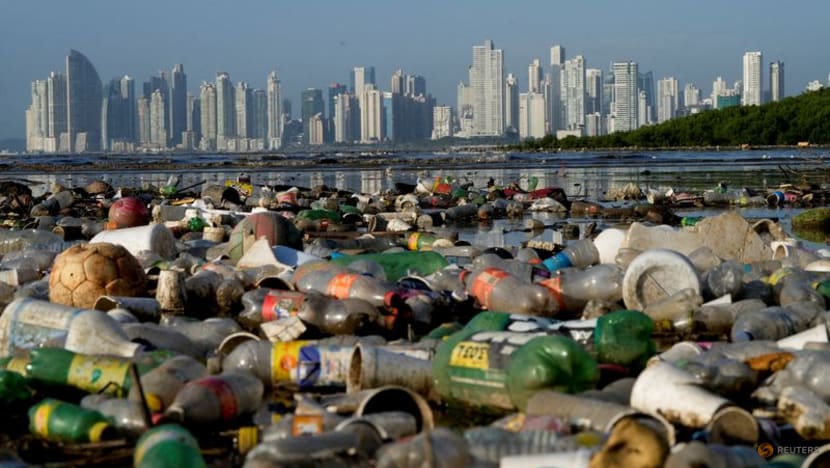Commentary: As negotiations on global plastics treaty stall, cleanup efforts are more vital than ever
Preventing plastic pollution is imperative, but we must not forget that plastic left in the environment does not disappear, say University of Toronto researchers.

Plastic polluting a mangrove area lies in Panama Bay, Panama City, Panama, Dec 6, 2024. (Photo: Reuters/Enea Lebrun)

This audio is generated by an AI tool.
TORONTO: Representatives at the recent United Nations conference in Geneva have once again failed to negotiate a binding global treaty to tackle plastic pollution.
The Switzerland gathering was the sixth round of talks in less than three years and was held after countries failed to reach an agreement at the 2024 meeting in South Korea. Chair of the negotiating committee, Luis Vayas Valdivieso, said countries will now work on finding a date and location for another meeting.
Plastic pollution is a global crisis. An estimated 23 million tonnes of plastic waste enters global aquatic ecosystems annually. This massive amount is expected to more than double by 2030 if we don’t change our relationship with plastic. To avoid this fate, we cannot focus just on prevention or cleanup – all actions to tackle plastic pollution must occur together.
Urgent and coordinated action is needed to reduce plastic production, redesign plastics to manage toxic chemicals and increase recyclability, improve waste management systems and clean up pollution.
Among these strategies, cleanup – recovering plastic waste from the environment – is often considered a lower priority compared to prevention at the source. Preventing plastic pollution is imperative, but we must not forget that plastic left in the environment does not disappear. It persists, accumulates, breaks apart into micro- and nanoplastics and continues to cause harm.
As long as we are producing plastics, there will be leakage into the environment. As such, cleanup is needed to mitigate ecological, economic and social impacts of plastic pollution now and in the future.
SCALING UP CLEANUP SOLUTIONS
Cleanup efforts are most often carried out by hand through volunteers. These can range from a couple of people cleaning their local park or beach to large groups coming together for an event.
Cleanups remove millions of kilograms of trash from the environment each year. However, with plastic pollution becoming an ever-growing problem, we need to increase cleanup efforts by orders of magnitude.
International collaboration is necessary to tackle this global problem. At the University of Toronto Trash Team, we came together with Ocean Conservancy to found the International Trash Trap Network (ITTN), a global network of local groups working together to clean up plastic pollution using trash traps.
Trash traps are technologies designed to clean up plastic waste from aquatic ecosystems. They range in design from simple river booms to roaming robots that clean beaches.
Trash traps are increasingly used to supplement manual cleanup efforts. They can work around the clock to target pollution, both on land and in waterways, cleaning areas that are unsafe or inaccessible for humans.
Some trash traps can also clean up small plastic waste, such as microplastics, that humans often miss as they are difficult to see.
With every trash trap programme in the network, local stakeholders come together to clean up plastic waste, monitor local sources and pathways, engage and inform communities about the issue, and contribute to an open-source global cleanup database to inform and motivate upstream solutions to prevent plastic pollution.
The ITTN serves as a platform for anyone using a trash trap to share their local impact and facilitate knowledge exchange to motivate and empower global action to clean up, monitor and prevent plastic pollution.
BENEFITS OF CLEANUP EFFORTS
Although cleanup primarily addresses the symptoms of plastic pollution, it can address the root causes through its additional benefits. Citizen scientists have recorded data on the weight and count of items they collect during cleanup events.
This is evident in the extensive datasets compiled by organisations such as Ocean Conservancy, which has logged 40 years of data from volunteer-led International Coastal Cleanup events.
Using this data, we can better understand local sources of pollution, identify prominent pollutants and prioritise specific solutions that will have the greatest impact. Policies to reduce single-use plastic consumption in Canada, and in US states like California and Maryland, have been developed based on evidence from cleanup data.
Cleanup data collection is a means for developing baselines and to measure policy efficacy. In the United States, shoreline cleanup data was recently used to demonstrate that plastic bag policies significantly reduced the proportion of plastic bags in shoreline litter.
Cleanup also serves as a powerful platform for public communication about plastic pollution. A significant driver of our plastic pollution crisis is human behaviour. As such, we must also consider how public understanding and perception of plastic pollution affects behaviour change and support for policy change.
Bringing communities together to clean up and share information facilitates community engagement and inspires hope. What’s more, by allowing individuals to encounter the problems caused by plastic pollution firsthand, this experience often changes their perspective on the issue from being just another news story to a reality.
The hands-on nature of cleanup empowers communities to act, reduce the issue and motivates calls for social and policy change.
Although cleaning your local park, beach or waterway might seem like a small act, it is an important tool for reducing plastic pollution, increasing awareness and informing polices that have lasting impact.
By strategically increasing cleanup efforts, we can target areas of greatest impact, incite behavioural change, and collect and share monitoring data. This can inform baselines, trends over time, reduction targets and solutions for plastic pollution – reducing the harm of plastic pollution while we work locally and globally to prevent it.
Chelsea Rochman is Assistant Professor of Ecology and Evolutionary Biology; Britta Baechler is Adjunct Professor, Department of Physical & Environmental Sciences; and Hannah De Frond is Research Scientist & International Trash Trap Network Manager at University of Toronto. This commentary first appeared on The Conversation.














